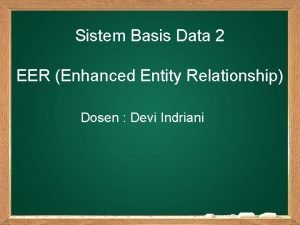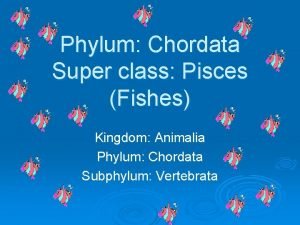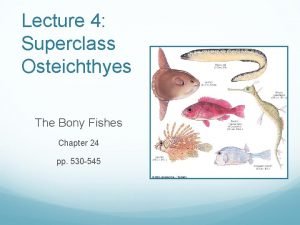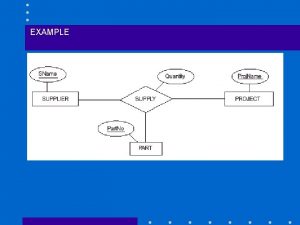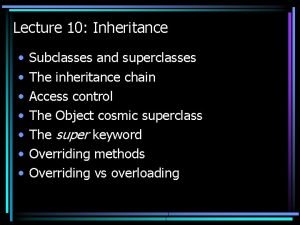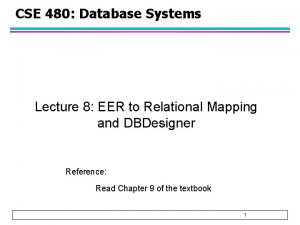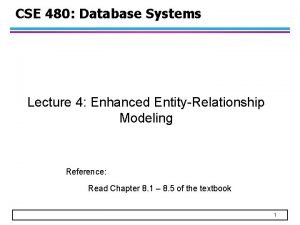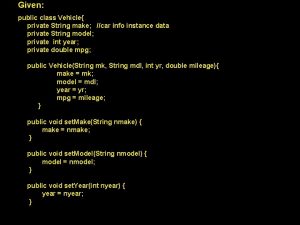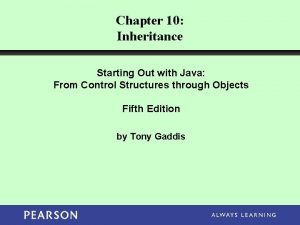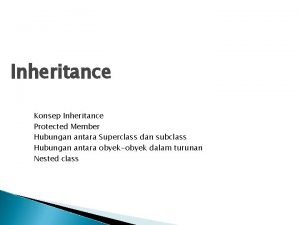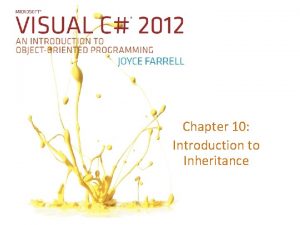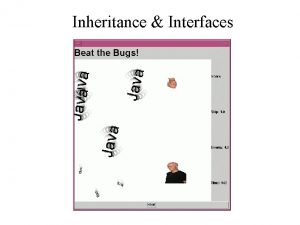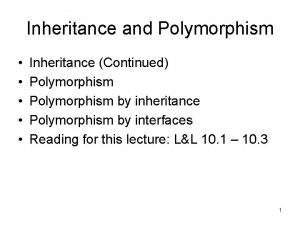1 Introduction to Inheritance What is Inheritance Superclass













- Slides: 13

1

Introduction to Inheritance Ø What is Inheritance? Ø Superclass vs. Subclass Ø Why Inheritance? Ø Subclass Syntax Ø Final Classes Ø Class Hierarchy Ø Subclass Constructors Ø Example Ø Exercises 2

What is Inheritance? Ø Inheritance is a mechanism for enhancing existing, working classes. Ø A new class can inherit from a more general existing class. Ø For Class Child: Ø Attributes: Ø Inherited: a , b Ø not inherited: c Ø Methods: Ø Inherited: op 1( ) , op 2( ) Ø not inherited: op 3( ) Parent a b op 1( ) op 2( ) Child c op 3( ) Ø Note: Constructors and private members of a class are not inherited by its subclasses. Ø Java supports single inheritance: A subclass has one parent only. Ø In multiple inheritance a subclass can have more than one parent. 3

Superclass vs. Subclass Ø Superclass: Ø A general class from which a more specialized class (a subclass) inherits. Ø Subclass: Ø A class that inherits variables and methods from a superclass but adds instance variables, adds methods, or redefines inherited methods. Course Student Graduate. Student Short. Course On. Line. Course defend. Thesis( ) produce. Certificate( ) deliver. Lecture( ) 4

is. A relationship Ø A subclass-superclass pair defines “is. A” relationship: Ø A graduate student is a student. Ø A short course is a course. Ø An online course is a course. Ø A graduate student is an object. Course Student Graduate. Student Short. Course On. Line. Course defend. Thesis( ) produce. Certificate( ) deliver. Lecture( ) 5

Why Inheritance? Ø Through inheritance we gain software reuse. Ø Helps in writing structured programs. Ø It is more natural and closer to real world. 6

Subclass Syntax class Subclass. Name extends Superclass. Name { variables methods } Ø Example: class Graduate. Student extends Student { String thesis. Title; . . . defend. Thesis(){. . . } 7

Final Classes Ø A class that is declared as final cannot be extended or subclassed. final class. Name { variables methods } Ø Examples of final classes are: Ø java. lang. System. Ø The primitive type wrapper classes: Byte, Character, Short, Integer, Long, Float, and Double. 8

Class Hierarchy Ø In Java, every class that does not extend another class is a subclass of the Object class. that is defined in the java. lang package. Ø Thus, classes in Java form a hierarchy, with the Object class as the root. Ø Example of a class hierarchy: 9

Subclass Constructors Ø To initialize instance variables of a superclass, a subclass constructor invokes a constructor of its superclass by a call of the form: super(paraneters); Ø This statement must be the first statement within the constructor. Ø Example: public Graduate. Student(int id, String name, double gpa, String thesis. Title){ super(id, name, gpa); this. thesis. Title = thesis. Title; } Ø If the first statement in a constructor does not explicitly invoke another constructor with this or super; Java implicitly inserts the call: super( ); . If the superclass does no have a no-argument constructor, this implicit invocation causes compilation error. Ø Constructor calls are chained; any time an object is created, a sequence of constructors is invoked; from subclass to superclass on up to the Object class at the root of the class hierarchy. 10

Example class Vehicle{ private String vehicle. Id. Number ; private String vehicle. Chassis. Number ; private String model ; public Vehicle(String vin, String vcn, String model){ vehicle. Id. Number = vin; vehicle. Chassis. Number = vcn; this. model = model; } public String to. String( ){ return "Vehicle ID = " + vehicle. Id. Number + "n. Vehicle Chassis Number = " + vehicle. Chassis. Number + "n. Vehicle Model = " + model; } public boolean equals(Vehicle vehicle){ return this. vehicle. Chassis. Number == vehicle. Chassis. Number; } } class Bus extends Vehicle{ private int number. Of. Passengers ; public Bus(int num. Passengers, String vin, String vcn, String model){ super(vin, vcn, model) ; number. Of. Passengers = num. Passengers ; } public int get. Number. Of. Passengers( ){ return number. Of. Passengers ; } } 11

Example (cont’d) class Truck extends Vehicle{ private double cargo. Weight. Limit ; public Truck(double weight. Limit, String vin, String vcn, String model){ super(vin, vcn, model) ; cargo. Weight. Limit = weight. Limit ; } public double get. Cargo. Weight. Limit( ){ return cargo. Weight. Limit ; } } public class Vehicle. Test{ public static void main(String[] args){ Vehicle vehicle = new Vehicle ("QMY 489", "MX-0054322 -KJ", "BMW 500"); Bus bus 1 = new Bus(30, "TMK 321", "AF-987654 -WR", "MERCEDEZ BENZ"); Bus bus 2 = new Bus(30, "2348976", "AF-987654 -WR", "MERCEDEZ BENZ"); Truck truck = new Truck(10. 0, "DBS 750", "RZ-70002345 -PN", "ISUZU"); System. out. println(vehicle) ; System. out. println(bus 1) ; System. out. println(truck) ; if(bus 1. equals(bus 2)) System. out. println("Bus 1 and Bus 2 are the same") ; else System. out. println("Bus 1 and Bus 2 are not the same") ; } } 12

Exercises Question 1: What inheritance relationships would you establish among the following classes: Student, Professor, Teaching Assistant, Employee, Secretary, Department. Chairman, Janitor, Person, Course, Seminar, Lecture, Computer. Lab Question 2: In the following pairs of classes, identify the superclass and the subclass: Manager -Employee, Polygon -Triangle, Person - Student, Vehicle - Car, Computer-Laptop, Orange - Fruit. 13
 Subclass erd
Subclass erd Pisces kingdom animalia
Pisces kingdom animalia Osteichthyes vs chondrichthyes
Osteichthyes vs chondrichthyes Can weak entity have subclass
Can weak entity have subclass Cosmic superclass in java
Cosmic superclass in java Hagfish characteristics
Hagfish characteristics Cosmic superclass in java
Cosmic superclass in java Extract superclass
Extract superclass Superclass
Superclass Cse 480
Cse 480 Superclass pisces
Superclass pisces Public class vehicle private string name
Public class vehicle private string name A subclass may call an overridden superclass method by
A subclass may call an overridden superclass method by Introduction to inheritance
Introduction to inheritance
